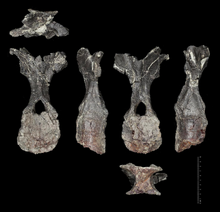Adratiklit
| Adratiklit Temporal range:
| |
|---|---|

| |
| Holotype specimen | |
| Scientific classification | |
| Domain: | Eukaryota |
| Kingdom: | Animalia |
| Phylum: | Chordata |
| Clade: | Dinosauria |
| Clade: | †Ornithischia |
| Clade: | †Thyreophora |
| Clade: | †Stegosauria |
| Family: | †Stegosauridae |
| Genus: | †Adratiklit Maidment et al., 2020 |
| Species: | †A. boulahfa
|
| Binomial name | |
| †Adratiklit boulahfa Maidment et al., 2020
| |
Adratiklit (meaning "mountain lizard") is an
El Mers III Formation (Bathonian–?Callovian),[1] near Boulahfa, south of Boulemane, Fès-Meknès, north Morocco.[2]
Discovery and naming
Adratiklit boulahfa was described by
Susannah C.R. Maidment, Thomas J. Raven, Driss Ouarhache and Paul M. Barrett on 16 August 2019 in an article published online in paleontological journal Gondwana Research; the article was published physically in January 2020. The holotype of Adratiklit boulahfa is a dorsal vertebra, NHMUK PV R37366. Referred specimens include three cervical vertebrae (NHMUK PV R37367 and NHMUK R37368, the latter specimen consisting of a series of two articulated bones), a dorsal vertebra (NHMUK PV R37365) and a left humerus (NHMUK PV R37007). The specimens were acquired by the Natural History Museum in the United Kingdom from fossil traders. They represent multiple individuals, probably five. While the second dorsal vertebra shares traits with the holotype, the other referrals are merely based on the fact that the material is stegosaurian. An attempt in 2018 to locate the site did not produce any relevant fossils but led to a deeper insight into the geology.[2]
The
Berber words "adrar", meaning "mountain", and "tiklit", meaning lizard. The specific name, boulahfa, refers to the area of Boulahfa near where the specimen was said to be found.[2]
Description

While the holotype for Adratiklit only includes a dorsal vertebra, a few other remains are known, including an upper arm bone and additional vertebrae. The fossilized humerus is 61 cm (24 in) long.[2] Adratiklit has an estimated body length of up to 7 metres (23 ft).[6]
The describers established two
neural canal. These traits are unique for the Stegosauria as a whole and are diagnostic to this taxa. The size of Adratiklit is not known due to a lack of fossil remains.[2]
Classification
Adratiklit is a basal
Dacentrurinae,[8]
which was previously thought to be confined to the Late Jurassic of Europe.
